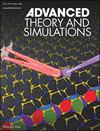212 MAX新相M2AB2 (M = Mo, Ta)的探索A = Ga, Ge)通过DFT计算
IF 2.9
4区 工程技术
Q1 MULTIDISCIPLINARY SCIENCES
引用次数: 0
摘要
本文提出了四种新的MAX相M2AB2 (M = Mo, Ta;A = Ga, Ge),并研究了其弹性、电子、热学和光学性质,以预测其潜在的应用前景。通过计算地层能量(EF)、地层焓(ΔH)、声子色散曲线(PDC)和弹性常数(Cij),证实了该方法的稳定性。研究表明,M2AB2 (M = Mo, Ta;(A = Ga, Ge)的弹性常数、弹性模量和维氏硬度值明显高于211类硼化物。Ta2AB2 (A = Ga, Ge)的维氏硬度值高于Mo2AB2 (A = Ga, Ge),这可以用键重叠居群(BOP)来解释。态密度(DOS)和电子能带结构(EBS)揭示了标题硼化物的金属性质。M2AB2的熔化温度(Tm)、grisen参数(γ)、最小导热系数(Kmin)、Debye温度(ΘD)等参数(M = Mo, Ta;A = Ga, Ge)。这些结果表明,与211 MAX相相比,所研究的化合物具有优越的热性能,适用于热障涂层(TBC)的应用。光学特性进行了测试,反射率谱表明材料具有减缓太阳加热的潜力。本文章由计算机程序翻译,如有差异,请以英文原文为准。

Exploration of New 212 MAX Phases: M2AB2 (M = Mo, Ta; A = Ga, Ge) via DFT Calculations
In this paper, four new MAX phases M2AB2 (M = Mo, Ta; A = Ga, Ge) are explored, and the elastic, electronic, thermal, and optical properties are studied to anticipate their potential applications. The stability is confirmed by calculating formation energy (EF), formation enthalpy (ΔH), phonon dispersion curve (PDC), and elastic constant (Cij). The study reveals that M2AB2 (M = Mo, Ta; and A = Ga, Ge) exhibits significantly higher elastic constants, elastic moduli, and Vickers hardness values than their counterpart 211 borides. Higher Vickers hardness values of Ta2AB2 (A = Ga, Ge) than Mo2AB2 (A = Ga, Ge) are explained in terms of bond overlap population (BOP). The density of states (DOS) and electronic band structure (EBS) reveal the metallic nature of the titled borides. The melting temperature (Tm), Grüneisen parameter (γ), minimum thermal conductivity (Kmin), Debye temperature (ΘD), and other parameters of M2AB2 (M = Mo, Ta; A = Ga, Ge) are computed. These findings suggest that the studied compounds exhibit superior thermal properties compared to 211 MAX phases and are suitable for thermal barrier coating (TBC) applications. The optical characteristics are examined, and the reflectance spectrum indicates that the materials have the potential to mitigate solar heating.
求助全文
通过发布文献求助,成功后即可免费获取论文全文。
去求助
来源期刊

Advanced Theory and Simulations
Multidisciplinary-Multidisciplinary
CiteScore
5.50
自引率
3.00%
发文量
221
期刊介绍:
Advanced Theory and Simulations is an interdisciplinary, international, English-language journal that publishes high-quality scientific results focusing on the development and application of theoretical methods, modeling and simulation approaches in all natural science and medicine areas, including:
materials, chemistry, condensed matter physics
engineering, energy
life science, biology, medicine
atmospheric/environmental science, climate science
planetary science, astronomy, cosmology
method development, numerical methods, statistics
 求助内容:
求助内容: 应助结果提醒方式:
应助结果提醒方式:


